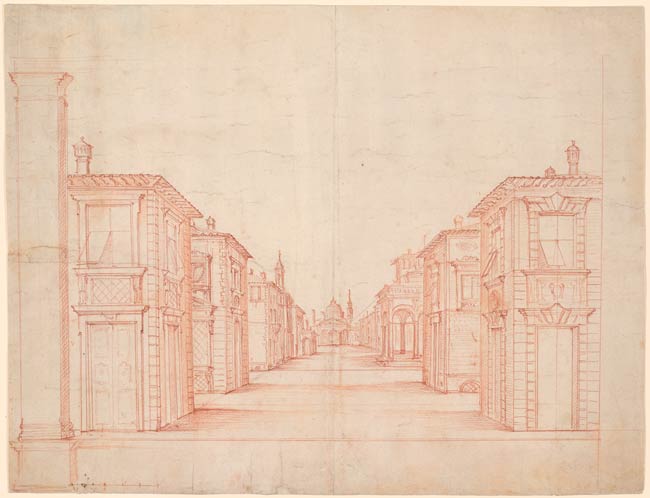
As the proscenium at left shows, this is a design for a theatre stage. The buildings that line the street converge at a point on the rear drop according to the principles of linear perspective. The setting was designed in accordance with Jacopo Vignola’s principles of stage perspective as illustrated in his Le Due Regole della Prospettiva Pratica, published in Rome in 1583 by Ignazio Danti after Vignola’s death. It has been suggested that the drawn architecture, which includes in the background, a church with a portico and in the right foreground a palace with a portrait bust in a niche, suggests a Ferrarese setting.1 Hans Hubert pointed out that scale at bottom measured in braccia, as indicated by the inscribed “B” at the lower left of the drawing, and that it was divided into ½ braccia. Since 1 braccia is usually about 58 cm, the height of the door in the foreground at left would be about 180 cm: about life-size (oral communication with Morgan curators, 2002). The braccia was commonly used in Florence and Milan but not throughout Italy – not in Rome, for instance, further supporting a Tuscan origin for the drawing.
Footnotes:
- New York and Elsewhere 1974-75, 19, no. 5.
Inscribed at center left, beside the door frame, in red chalk: "V;" throughout, as labels with architectural measurements, in red chalk: "2 1/2; 3; 2 1/4; 6; 2; 4 1/2; 6; " Scale ruled at lower left and inscribed "B" at one of the markings at left. Inscribed on verso, on piece of paper pasted to lining, in dark brown ink: "Prospettiva dal Callotti" (probably taken from an old mount or backing).
Watermark: Fleur-de-lis in circle (Ferrara 1550?).
Oenslager, Donald, 1902-1975, former owner.
Selected references: New Haven 1964, no. 4 (as unknown artist, north Italy, about 1560); New York and elsewhere 1974-75, 19, no. 5 (as unknown Italian artist, sixteenth century); Oenslager 1975, 32-33, no. 6.
Donald Oenslager. Four Centuries of Scenic Invention : Drawings from the Collection of Donald Oenslager. Washington, D.C. : International Exhibitions Foundation, 1974, no. 6, repr.

